Leaving your dog behind during vacations can be difficult for many pet parents. For some trips, going without your dog is in the best interest of everyone, but there are some instances where traveling with dogs is beneficial or even necessary. Thus, it’s best to prepare for traveling with your pet well in advance to make the process go as smoothly as possible.
This article will cover tips for traveling with your dog, finding a place to stay, and planning dog-friendly activities. Before traveling with your dog the first time, it’s best to visit your vet to make sure the trip will be safe and enjoyable for your furry friend.
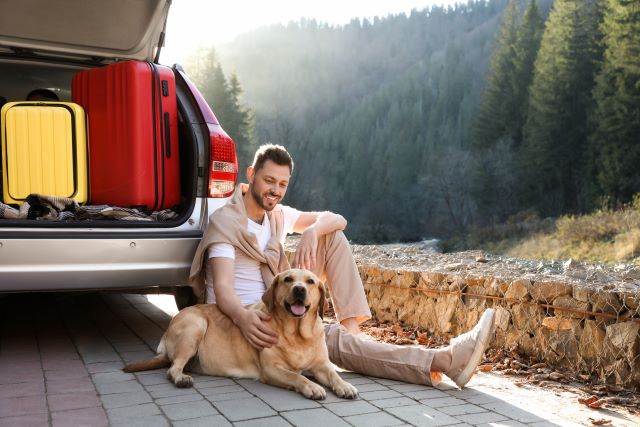
Should You Travel with Your Dog?
Whether or not you should travel with your dog depends on your dog’s personality and health. If your dog gets anxious easily, bringing them on a trip isn’t ideal. However, some dogs are great at adapting to new situations and love exploring different places, so those dogs would probably do well on the go.
Regardless of your dog’s temperament, there may be times when they need to travel with you, such as if you’re moving to a new location. If that’s the case, you may need to take extra precautions to ensure they’re as comfortable as possible. That could include stopping more frequently during a long drive or asking your vet about whether or not medications could help.
What to Pack When Traveling with Your Dog
Your dog may not need as much stuff as you do for a trip, but they still need the essentials. Plus, bringing items that look and smell familiar to your furry friend can help them feel more comfortable.
Here’s a list of supplies you should bring for your dog:
- Up-to-date identification tags
- Collar, harness, and leash
- Plenty of healthy dog food
- Medications (if they have any)
- Pet first aid kit
- Food and water dishes (collapsible bowls are the most convenient)
- Poop bags
- Vet records (some airlines, hotels, and events may require them)
- Crate (if you need to confine your dog in the hotel)
- Dog seat belt for car (unless you’re keeping them in a crate)
- Airline carrier (if you’re flying)
- Treats, toys, dog bed, and anything else that could help your dog feel more comfortable
This list is just a general guide of things you may need. Your packing list may vary based on where you’re going, how you’re getting there, and what activities you have planned. If you have space to spare, it can’t hurt to pack extra pet supplies out of caution.
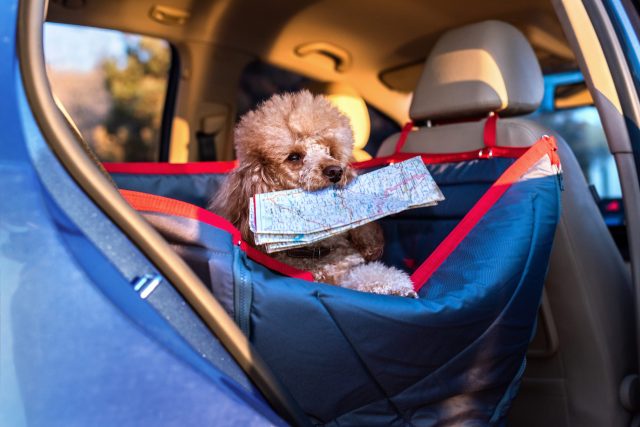
What to Include in a Dog First Aid Kit
You can buy a dog first aid kit that’s already put together or you can gather supplies for one yourself. Either way, you should make sure the kit includes gauze, non-stick bandages, adhesive tape, disposable gloves, a towel, a thermometer, tweezers, and scissors with a blunt end. You may also want hydrogen peroxide (3%) to induce vomiting in emergencies, but it’s best to consult a vet before using it. Before heading on your trip, make sure you have your veterinarian’s number and the number of a local veterinarian saved in your phone or written down.
What you choose to include in your first aid kit may vary based on where you’re traveling to and what activities you’ll be doing. It’s always better to be safe than sorry by packing as many beneficial items as you can, especially if you’re planning to go hiking.
One life-saving product that may not be included in standard pet first aid kits is an emergency at-home detoxifier, such as ReadyRESCUE by Dr. Cuddles. If your dog eats something they shouldn’t, such as toxic human foods like chocolate or grapes, human medications, or chemicals, you can serve them this product with food, treats, or water so it can quickly attack the toxin and prevent it from being absorbed into your dog’s body.
Finding a Dog-Friendly Hotel
While planning your trip, make sure you find a dog-friendly place to stay. Many lodging options, whether they’re a large hotel chain or a small local property, are willing to allow pets with some restrictions. The best way to know if your dog is welcome is to call the property before booking.
Looking for a pet-friendly hotel so you can share your vacation with your four-legged friend? We’ve partnered with top travel sites to find you the best possible deals around. Just enter your travel plans below, and you’ll find pet-friendly hotels wherever you’re traveling.
Pet-Friendly Hotel Chains
While it may vary based on location, there are lots of popular hotel chains that allow pets. Most will charge an additional fee, and some may have special features for your furry friends.
- Best Western – Best Western has over 2,100 pet-friendly hotels worldwide. Up to two dogs, each under 80 pounds, are allowed at those locations for around $30 per day or $150 per week.
- Choice Hotels – This brand has around 3,500 pet-friendly U.S. hotels, including Radisson, Quality Inn, and Comfort Inn locations. Most locations allow up to two dogs per room, but prices and weight restrictions may vary.
- Hilton – Over 5,000 hotels across the U.S. and Canada, such as DoubleTree and Homewood Suites, welcome dogs. The fees and restrictions vary greatly between each location.
- IHG Hotels and Resorts – IHG owns a variety of popular hotel chains that have pet-friendly locations, including Holiday Inn, Hotel Indigo, and Kimpton. Contact the individual location for more info on pet restrictions.
- Hyatt – Hyatt hotels allow two dogs per room at many locations, as long as the combined weight of the two dogs doesn’t surpass 75 pounds. The fee is about $75 but may be increased if you stay over a week.
- Marriott – Lots of pet-friendly chains are owned by Marriott, such as Aloft, Westin, and Sheraton. Many of these hotels also offer pet products with your hotel room upon request.
- Motel 6 – Well-behaved pets can stay for free at Motel 6, but some locations may require a $10 per day fee (maximum fee of $100 per stay). The limit is two pets per room.
- Red Roof Inn – Most Red Roof Inn locations allow pets to stay free of charge, but most have a weight limit between 40 and 80 pounds. However, pets should not be left unattended at this chain.
- Wyndham – Wyndham has many pet-friendly chains, including La Quinta, Baymont, Days Inn, and Super 8. No more than two pets are allowed per room, and fees and weight restrictions can vary greatly, so call the location for the most accurate information.
While this list includes many of the companies that offer pet-friendly accommodations, there are plenty of smaller chains and local businesses not listed. Always check a hotel’s pet restrictions before booking.
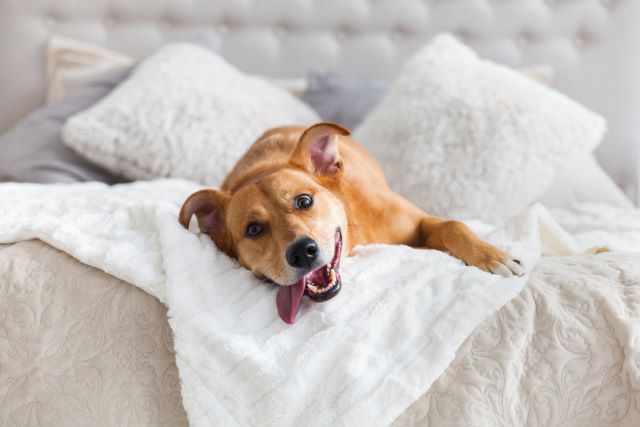
Other Lodging Options
Even though most popular hotel chains allow pets to some extent, they still might not be the right choice for you. Many prevent large dogs or more than two dogs at a time. Some may also prevent you from leaving your dog alone in the hotel, which can be difficult if you have some plans that aren’t pet-friendly.
So, if you’re struggling to find a good hotel, you may want to check other types of lodging, such as campgrounds or booking sites like Airbnb and Vrbo. Those options are often more flexible with pet restrictions because they don’t need to follow the policies of big chain hotels. Like with hotels, you should always contact the property to get the most detailed information on their pet restrictions.
Dog-Friendly Transportation Options
For most dogs, the scariest part of going on a trip is getting there. Dogs who aren’t used to riding in the car are likely to be anxious during a road trip and even more so on an airplane. So, here are some tips for how to keep your dog safe and comfortable when heading to your destination.
Driving with Your Dog
If possible, driving long distances with your dog will usually be easier and more comfortable than flying, especially if you have a large breed. However, you should make sure your dog is okay with riding in the car before you bring them on a road trip. If they don’t ride in the car much on a regular basis, start by taking them for short drives in preparation for the trip.
Here are some tips for taking a road trip with your dog:
- Get your dog’s energy out before the long drive (take them for a walk, play fetch, etc.)
- Make sure your dog is secure and comfortable (use a crate or dog seat belt, and make sure they have a cozy bed)
- Stop more often than you need to so your dog can stretch their legs and do their business
- Offer your dog fresh water every time you stop
- Never leave your dog alone in the car on a warm/hot day
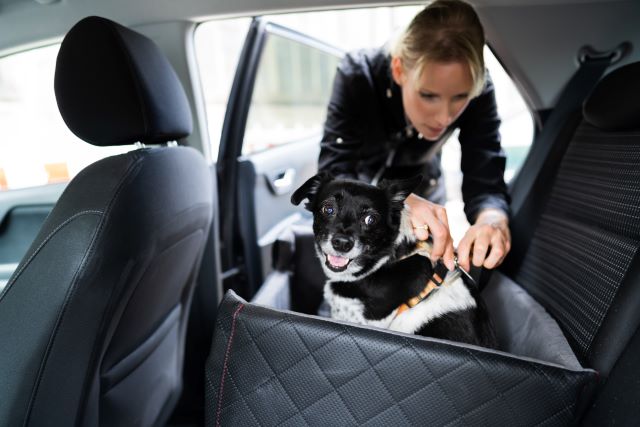
Flying with Your Dog
Most dogs have ridden in the car at one point or another, but flying with your dog is a much different experience. If your dog is under 20 pounds, they can ride in the cabin on most airlines, but if your dog is larger than that, they may have to fly in the cargo hold. Not being able to see your dog during the flight can be stressful, which is why families with larger dogs typically prefer to drive when possible.
Almost every airline allows dogs, but some have stricter rules than others. Always check an airline’s pet policy before planning to fly on it with your pup.
Below are a few steps to take when flying with your dog.
Make Sure Your Dog Should Fly
Just because a dog is small enough to fly in the cabin doesn’t mean they should. Dogs that are likely to be anxious or cause a disturbance during a flight aren’t recommended to fly. Dogs prone to breathing problems, such as French Bulldogs and Pugs, are also not recommended by most airlines because they have higher risks involved.
However, sometimes flying is your only option for travel, so if you’re worried about how your dog will behave during a flight, ask your vet for advice. In some cases, your vet may prescribe medications to help calm your dog. Even if you suspect your dog will be fine on a plane, a health checkup beforehand is always a good idea.
Get an Appropriate Carrier
Next, pick out a carrier for your dog. Every airline has different restrictions for in-cabin and cargo pet carriers, so if you know which airline you’re using, look up their restrictions when choosing a carrier. As a general rule of thumb, in-cabin carriers should be able to fit under the seat in front of you for the whole flight while still having enough space for your dog to comfortably lay down and turn around.
Make sure the carrier is also comfortable for your dog, including soft bedding in the bottom and ventilation on several sides. Practice carrying your dog around in the bag before the day of your flight to make sure they’re comfortable in it. Using treats in and near the carrier can help your dog associate it with something positive.
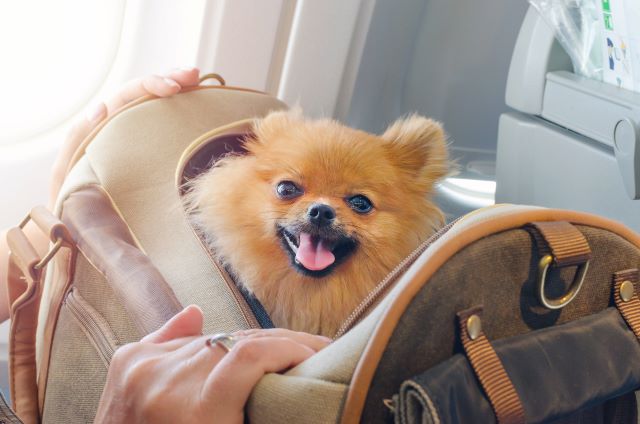
Before Going to the Airport
Before going to the airport, make sure your dog does their business. Some airports have dog bathrooms inside, but not all dogs are willing to pee on the artificial grass. So, it’s best to make sure they go at home or outside the airport because they might not get another chance until after the flight.
Also, make sure you have all your dog’s necessities during the flight just in case. This includes your dog’s leash, a water bowl, and anything you might need to clean up after your dog, such as poop bags and paper towels. Even if your dog is potty trained, they could have an accident or throw up in an unfamiliar setting, so it’s better to be safe than sorry.
You should also have your dog’s vet records accessible. All airlines require some vaccines for your dog, and while they may not always ask for proof, it’s best to have it on you to ensure your dog is allowed on the plane.
Bringing Your Dog Through Security
Once you’re at the airport, bringing your dog through security can be stressful, especially since there’s so much contradicting information on how to do it. The best way to know what to do is to ask an employee at the airport, and they can guide you in the right direction. If you’re at a busy airport, they may ask you to go into the handicap line so you don’t hold up the regular line. Dogs in cargo are dropped off with checked bags, so they don’t need to go through security.
When you go through security with your dog, you must take your dog out of the carrier and send the carrier through the machine. Then, you’ll walk through security while holding your dog, but after you’re through, you’ll need to wait for an employee to test your hands before you can proceed. The employees can help guide you through this process.
During the Flight
At the airport and on the flight, your dog is supposed to stay in the carrier at all times. Some flight attendants might not care if your dog’s head is sticking out, but if they ask you to close the carrier completely, you need to do so. Your dog must stay under the seat in front of you for the whole flight, so you cannot put them in your lap.
Once your flight lands, take your dog outside to do their business as soon as you can.
How to Travel with an Anxious Dog
If you have an anxious dog, driving and flying might both seem tricky. Luckily, there are things you can do to help a stressed-out dog feel more at ease while on the go.
- Get your dog familiar with travel – take them to places they enjoy, such as the park, instead of only the vet.
- Bring familiar items, such as their favorite beds and toys.
- Keep their feeding times and bathroom breaks as close to their normal routine as possible.
- Give them lots of exercise before getting in the car or entering the airport.
- Stay calm – your dog may pick up on if you’re stressed and become more worried as a result.
- Try anti-anxiety products, such as ThunderShirts and heartbeat toys.
While the above tips may reduce your dog’s anxiety, extremely anxious dogs will likely still show some fear in unfamiliar situations. Pet CBD Products, such as those made by Cannanine, can help calm down nervous pups during travel. Cannanine offers CBD oil and soft chews, both of which effectively calm dogs while being THC-free. Plus, every Cannanine product purchased donates meals to shelter dogs.
Picking Activities Your Dog Can Join
If you’re traveling with your dog for vacation, you should make sure they can join you for most, if not all, of your activities. Since dogs aren’t allowed indoors in many places, you should travel when the weather is nice to ensure you can spend time outside with your furry friend.
Here are some ideas of dog-friendly vacation activities:
- Go hiking
- Explore a historic town or city
- Check out local parks
- Visit dog-friendly beaches
- Rent a boat (canoe, kayak, pontoon boat, etc.)
- Go to outdoor markets
- Eat at outdoor patios at restaurants
- Stay at a campground
- Go to a drive-in theater
- Visit a dog-friendly winery
- Check for other dog-friendly events at your destination
This is just a list to get you started because the dog-friendly activities will vary based on where you’re visiting. While most outdoor events welcome pets as long as they’re well-behaved and you clean up after them, it’s always a good idea to check the event’s details to be sure. With enough planning and good weather, you can hang out with your dog the entire vacation!
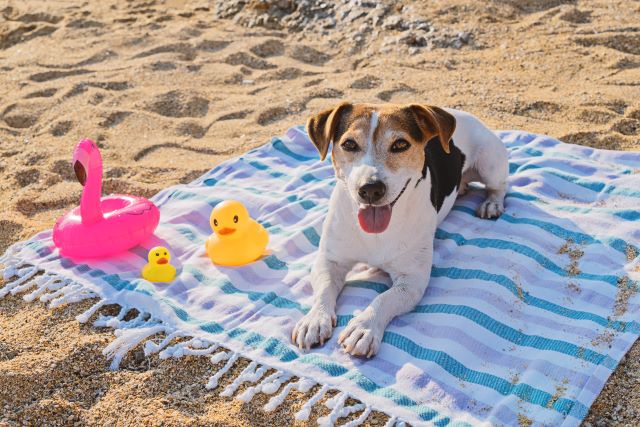
Frequently Asked Questions
Is it Safe for Dogs to Travel on a Plane?
Yes, it’s generally safe for dogs to travel on a plane. However, there are risks, especially for brachycephalic breeds (like Bulldogs and Pugs) due to their respiratory structure. It’s crucial to check airline policies, ensure the carrier is well-ventilated and secure, and consult with a veterinarian before flying to ensure your dog’s safety and well-being.
Where Do Dogs Go to the Bathroom During Flights?
During flights, dogs typically do not have a designated area to go to the bathroom. Owners are advised to limit food and water intake before the flight and to give their dogs ample opportunity to relieve themselves before boarding. If a flight is long, some dogs might wear a diaper or absorbent pad in their crate, but ideally, flights should be short enough to avoid this need.
How Often Should You Take Breaks on a Road Trip with Dogs?
On a road trip with dogs, you should take breaks every 2-3 hours for bathroom, hydration, and exercise.
Do Dogs Need to Be Restrained in the Car?
Yes, for the safety of both the dog and passengers, dogs should be restrained in the car, either using a crash-tested harness, seat belt, or secure crate. This prevents them from flying forward during sudden stops and makes them less distracting for the driver.
Do National Parks Allow Dogs?
National parks have varying policies. Some allow dogs in specific areas or on certain trails, while others may have stricter restrictions or not permit them at all. Always check the specific park’s policy before visiting with a dog.
Are There Any Dog-Friendly Restaurants?
Yes, many restaurants with outdoor patios or seating areas allow dogs. However, dogs aren’t allowed inside restaurants for health reasons. Policies vary by establishment and local regulations, so you should check in advance or look for establishments with “dog-friendly” signage.
Do I Need to Quarantine My Dog if Traveling Internationally?
Quarantine requirements for dogs traveling internationally vary by country. Some countries require quarantine upon arrival, while others may not if specific health and vaccination criteria are met. It’s essential to research the destination country’s pet importation rules in advance.
Final Thoughts
There’s a lot to plan before traveling with your dog for the first time, but it can be worth it to have your furry friend by your side every step of the way. With so many pet-friendly hotels, airlines, and activities, you’ll have no trouble planning a vacation with your pup. However, if your dog gets nervous in the car or at unfamiliar places, it might be best to leave them behind when traveling if possible.
 Toledo, United States.
Toledo, United States.